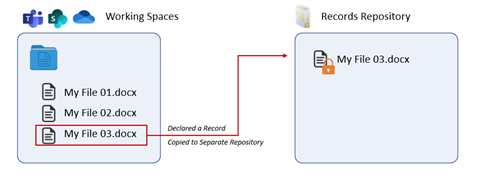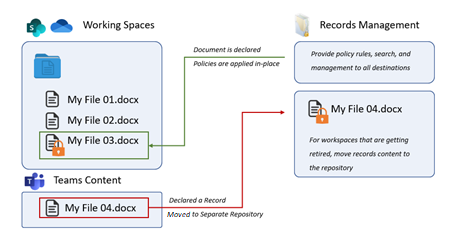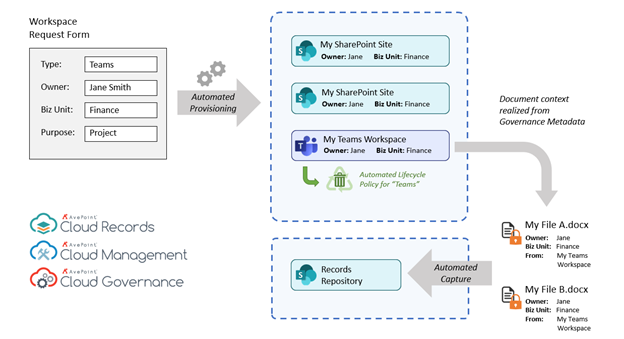In-Place vs. Out-of-Place Records Management: New Insights for 2021

When customers are embarking on a Records Management journey with Office 365, one of the very first up-front decisions that need to be made is whether to take an in-place approach or out-of-place approach to managing records. In previous articles on the topic, AvePoint has made no secret about our position that out-of-place repositories are a more traditional approach, while an in-place strategy is more future-facing.
However, there are times when adding an out-of-place approach as a component of your overall strategy can be useful in some situations. Let’s take a look.
In-place vs. out-of-place records management: A refresher
For those who are new to the RM space, the concepts of “in-place” and “out-of-place” might be unfamiliar, so let’s recap on those quickly:
“Out-of-place” storage is a legacy approach to digital records management – many readers will be familiar with the traditional records repositories of the past, where an external system or storage repository sits outside of the location of the information, and items marked as records are sent separately to the repository. This can be seen with having legacy dedicated external systems, or even within classic SharePoint’s concept of a “Records Center” that had a completely separate Site Collection that records were “sent” to.
 While this approach overcame many traditional challenges from legacy document systems (such as file shares), by being able to add additional management and control to the storage of files and providing a benefit of “localizing” or “centralizing” the search and management or Records to a single repository, this approach did not adapt well with the evolution of the digital workspace. As our workspaces became more varied and complex, and control and search improved within existing systems, the traditional out-of-place approach began to introduce challenges such as losing the context of the location that the document came from, unintentional duplication of content in multiple locations, and additional complexity in managing user roles/permissions from the source to the repository.
While this approach overcame many traditional challenges from legacy document systems (such as file shares), by being able to add additional management and control to the storage of files and providing a benefit of “localizing” or “centralizing” the search and management or Records to a single repository, this approach did not adapt well with the evolution of the digital workspace. As our workspaces became more varied and complex, and control and search improved within existing systems, the traditional out-of-place approach began to introduce challenges such as losing the context of the location that the document came from, unintentional duplication of content in multiple locations, and additional complexity in managing user roles/permissions from the source to the repository.
On the other hand, the “In-place” approach to Records Management is a more modern approach, using the modern technology platform’s search and controls to apply records control policies to the same document in the same location where collaboration or work happens. This has the advantage of keeping the security, location, and informational context fully intact as well as reducing duplication as the policies are applied to the source document in-place without needing to move or duplicate it to another location.

When is out-of-place records management a good idea?
As mentioned above, AvePoint is a strong believer in staying ahead of industry trends and will often make recommendations for customers towards in-place records strategies where it makes sense to do so.
Having said that, while it’s good to have an approach or strategy, it doesn’t mean there aren’t exceptional use-cases that appear from time-to-time that require adjusting the approach to meet a customer’s specific needs.
Check out this post on records management, there are some pretty helpful tips: Click To TweetOne such example recently occurred with a customer who was adopting a primarily in-place records strategy for their Microsoft 365 artefacts, but also saw an increased uptick in “disposable” Microsoft Teams workspaces being created for ad-hoc and Work From Home initiatives. This brought about two major realizations for the customer:
- Proper lifecycle management rules were becoming imperative in order to manage the proliferation of Teams that were being created and not subsequently retired,
- They now had competing goals of wanting to maintain in-place management of records while simultaneously wanting to perform “spring cleaning” and remove the very workspaces that would otherwise contain the in-place records.
This challenge of wanting to keep their workspace management pruned for continued future growth while also recognizing that was at odds with leaving spaces in-place for the long haul brought them to AvePoint to revisit their overall approach to records, governance, and lifecycle management in their environment.
Why Governance and Records are better together
AvePoint brainstormed a number of alternatives with the customer and proposed an out-of-place component as part of their wider overall in-place solution, specifically to address the scenario of balancing lifecycle management with records retention for Microsoft Teams. This combination approach would allow the flexibility of maintaining an in-place approach for the majority of their records while also accounting for important files within Teams that need to be retained without needing to keep the entire Teams workspace that’s housing it, thus allowing for Teams workspace cleanup.

This is where Governance and Records work hand-in-hand – one of the major arguments against an out-of-place strategy is losing the location context around the original document. Having a strong Governance strategy for Microsoft 365 workspaces provides the blueprint for capturing and managing the context around workspaces in an organized fashion, allowing this to be easily leveraged in a RM scenario.
For example, the customer was able to realize an outcome that leveraged AvePoint’s suite of cloud offerings for a fully automated end-to-end lifecycle management solution. This consisted of the following aspects:
- Using Cloud Governance to provision and track workspaces such as SharePoint and Teams, capturing business-critical information on Ownership, Security, and Lifecycle policies.
- Using Cloud Records for managing in-place content where appropriate
- When the renewal period for a Teams workspace has ended, before the Team is archived/deleted, any flagged records are relocated to a SharePoint-based long-term Records Repository. This way they retain critical business information about the workspace it came from and appropriate ownership and context.

The value of a hybrid strategy for records management
As described in the example above, while an in-place Records strategy was appropriate for much of the content in the customer’s environment, they also realized that with the growing proliferation of Teams workspaces, they didn’t want to keep all them available for decades; they instead preferred to focus on balancing Records mandates against usability and housekeeping needs. This is why a hybrid approach of select out-of-place capabilities—coupled with a strong Governance-first initiative for capturing and maintaining metadata and context around the content—is so valuable when creating a strong Records Management strategy.
For more records management insights, be sure to subscribe to our blog.
As a Senior Vice President within AvePoint spearheading new strategic solutions, Timothy's current role is leading MaivenPoint in North America - AvePoint's cutting-edge EdTech solution vertical across both the Education sector, and across commercial Corporate sector for Learning & Development initiatives. A Microsoft Certified Professional and modern workplace productivity expert with more than 20 years of experience, Timothy brings perspectives that are not just about learning, but also where and how this fits in the 'bigger picture' of org-wide technology investments, knowledge management, governance, employee experience, and more, with hands-on experience across both Public and Private sectors.



